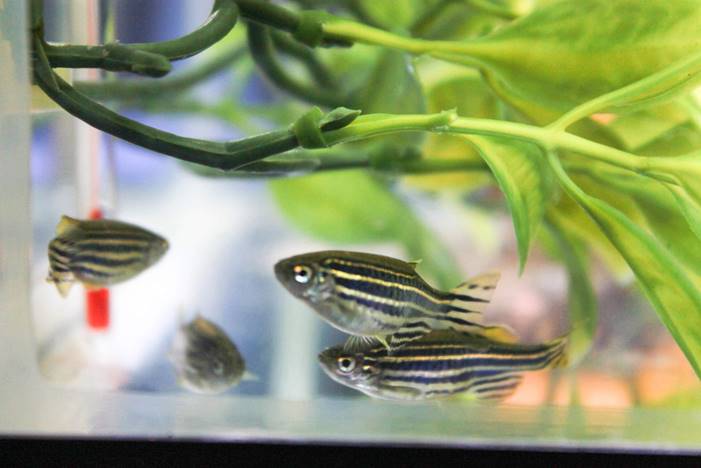Frogs, earthworms and zebrafish: how Calvin uses live animals in lab
Calvin uses live animals in teaching laboratory courses
When COVID-19 sent college students home to take classes from their childhood bedrooms, there were unanticipated casualties: laboratory animals.
“We had all these frogs,” biology professor Erica Boldenow said. “We were going to use them for physiology labs, but once everything shut down we didn’t need as many as we had ordered.”
Boldenow used as many of the frogs as possible to perform and record the physiology experiment. However, a majority of the frogs weren’t used, and she had to find other options to take care of them.
“When you develop lab protocols,” Boldenow said, “you include information about what to do in emergencies. It’s in the protocol that you should euthanize them.” She said she looked into other possibilities, such as releasing the frogs into the wild.
“Unfortunately the frogs aren’t native and would pose a threat to the environment,” she said.
As a result of the pandemic, she had to pith the frogs that weren’t used for the virtual laboratory experiments.
“No researcher that uses animals enjoys euthanizing the animals that they work with,” Boldenow said. “We respect them and know the value that they are giving us in terms of data and research, but we don’t like doing it.”
Calvin’s science program, like most colleges and universities, uses live animals for student laboratory experiments. The usage of the animals varies depending on the lab. In one course, students are required to cut off the tail of a zebrafish while the fish is still alive in order to collect a blood sample to measure the levels of stress hormones in the fish’s blood.
In other experiments, the professor “piths” the animal—inserts a needle through the rear base of an animal’s skull—to destroy the brain. The other tissues, such as the heart or digestive tract, remain functional for students to investigate.
In another experiment, students use recently collected earthworms to study nervous function. The earthworms do not die and are released back into the ground when the experiment is completed.
Calvin’s usage of animals follows protocols and guidelines developed by the National Institutes of Health. The determination to use laboratory animals is guided by three “R’s”: replacing animals with non-animal experiments when possible, reducing the number of animals used and refining experiments to decrease harm and ensure respect of the animals used.
“We ensure that our animals are housed correctly and that they receive drugs for any pain they may be feeling,” Boldenow said.
The Institutional Animal Care and Use Committee (IACUC) oversees laboratory protocols. IACUCs include science faculty, non-science faculty and community members. All experiments that use vertebrate animals must be submitted to the IACUC.
“The application includes questions about the study design, what the study is, and whether the study is really necessary,” Boldenow said. “You have to justify the three Rs. If there’s an alternative that can be used, we want to use that alternative.”
Calvin has found alternatives for animal usage. In the past, upper-level biology students used frogs to investigate nerve function; in the current curriculum, students use an electrical shock system to painlessly make their own fingers twitch.
Boldenow noted that using live animals is an opportunity that allows many students to understand material.
“There’s a lot to be learned by handling an animal at least once in your biological career,” Boldenow said. “Opening up a live animal is different than opening up a dead animal–you can see the different colors, what tissues are oxygenated and deoxygenated.”
Zach Priebe, a junior biology major, appreciated and respected the labs that he used live animals in. “It’s been helpful for giving that connection between what you learn in class and seeing the anatomy and physiology in the real world.”
Priebe noted that he could see the concerns that people have, particularly when students aren’t able to handle animals correctly. “When there were labs that could have animal harm, the professors and lab TAs would do anything that we weren’t able or trained to do,” Priebe said.
“There’s a certain level of respect for the animal,” Priebe said. “You just get the data you need to collect.”
Philosophy professor Matt Halteman noted the ethical issues associated with the use of animals in research. “Not all unique benefits that we can obtain from doing harmful things to someone else can morally justify the doing of those harms,” Halteman said in an email to Chimes. “Getting a unique benefit from harming and killing animals in experimental research doesn’t justify doing those harms all by itself.”
“I advocate for the abolition of the use of animals in harmful, non-therapeutic, non-consensual research,” Halteman said. “Proponents of animal research face a two-fold burden of proof: first, show that it is uniquely necessary to do what you’re doing; second, show that these unique results you can’t get any other way justify doing harmful things to animals that it is immoral to do to unwilling human beings. Nobody seems to have succeeded at meeting these difficult burdens.”









Lord Cavendish • Aug 17, 2021 at 6:43 pm
Again, I am happy that the Spectrum lab, which conducted live animal testing on Calvin’s campus, has closed. Doing “practice surgeries” on animals, one of the claims a Calvin official touted about that facility, is reprehensible.
I wish there were more people at Calvin like Philosophy professor Matt Halteman who speaks truth to power. Where is professor Kuperus? Where is professor Warner?